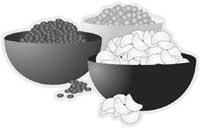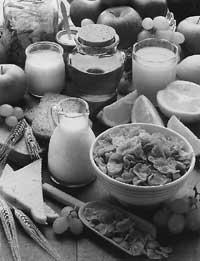Legumes: ingredients of the Mediterranean diet
1999/09/01 Lorenzo, Arantza | Uranga, Ane Miren Iturria: Elhuyar aldizkaria
Like many other things, the Romans brought legumes to our culture. Legumes are plants that carry the fruit inside the pod and, in most cases, serve to feed the seeds that are inside it. Lentils, chickpeas, beans, dried beans and soy are the ones we eat most among us.
Despite
its importance in food, consumption of legumes has decreased considerably in European countries. In Euskal Herria, in that European, we consume less and less legumes. Legumes are mainly composed of complex carbohydrates (55-65%) and proteins (20-25%). The most abundant carbohydrate in these dry foods is starch and to a lesser extent fiber (cellulose, hemicellulose and pectin). Fiber should be taken into account, the intestines cannot digest, so the fiber in the skin of legumes cleans the intestines. To facilitate the assimilation of the fiber, legumes are soaked before cooking (usually the eve), as this way the skin of legumes is softened and the wind problem in the intestine is reduced. For those who have intestinal problems: colitis, dyspepsia, diets poor in fibers, etc. legumes are not good.

Legume
proteins are scarce in sulfur amino acids (methionine and cysteine), but abundant in lysine amino acids. Therefore it is good to mix with legumes foods with opposite properties, many sulfur amino acids and few lisines, which are complemented in this way, putting the value of these proteins to the height of the proteins of meat or fish. Cereals, for example, contain many sulfur amino acids and little lysine. Therefore, they are ideal to accompany legumes and, for example, if we add some rice in the preparation of lentils, we would have a meal rich in protein.
Legumes
have little fat, between 1 and 3% on average, chickpeas 5% and soy 18%. Remember that some sauces and margarines are often prepared with soy. Beginning to identify them, legumes are not given the surname of the regulatory food because they have little vitamin and mineral salt, but those that have them in large proportion, especially iron,
phosphorus, calcium, potassium, magnesium and iodine. Legumes contain B vitamins, but in order to take the iron they contain they need vitamin C. Therefore, it is advisable to accompany legumes with foods rich in vitamin C, such as peppers, tomato, etc., since you can better take advantage of the iron contained in legumes.
If we eat legumes 2-3 times a week, well. And when you eat, you should eat empty or mixed with vegetables (carrot, peppers, leeks, onion, potato…). Taking into account all the proteins present in a dish of legumes, if you take previously a salad or a soup and take a dessert to finish, it would be enough to complete the meal excellently.

Gai honi buruzko eduki gehiago
Elhuyarrek garatutako teknologia




